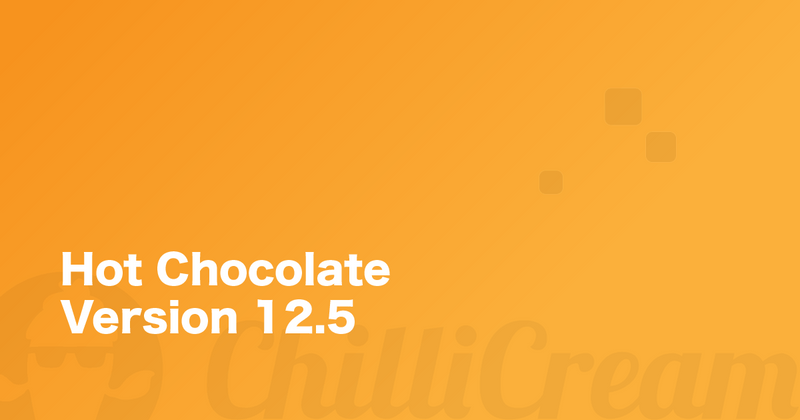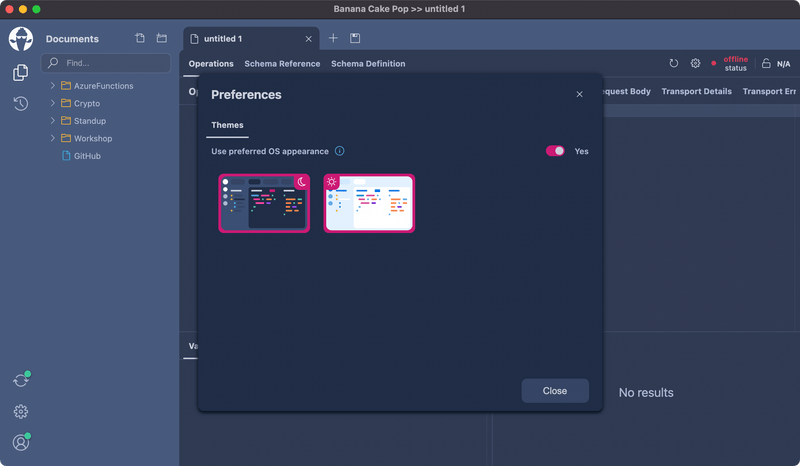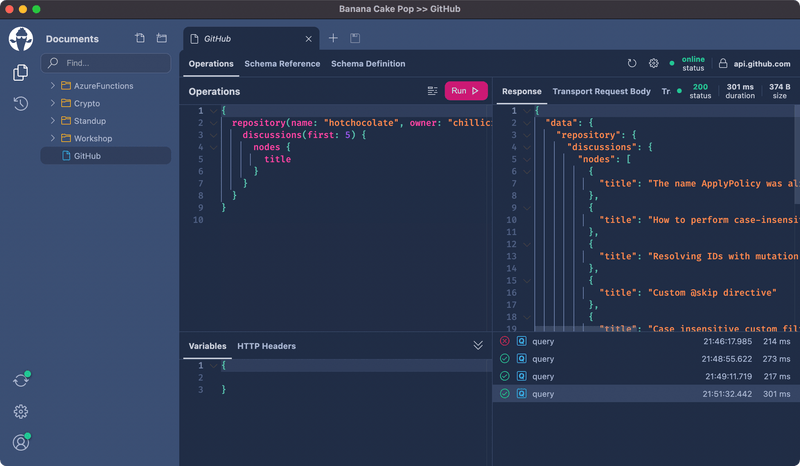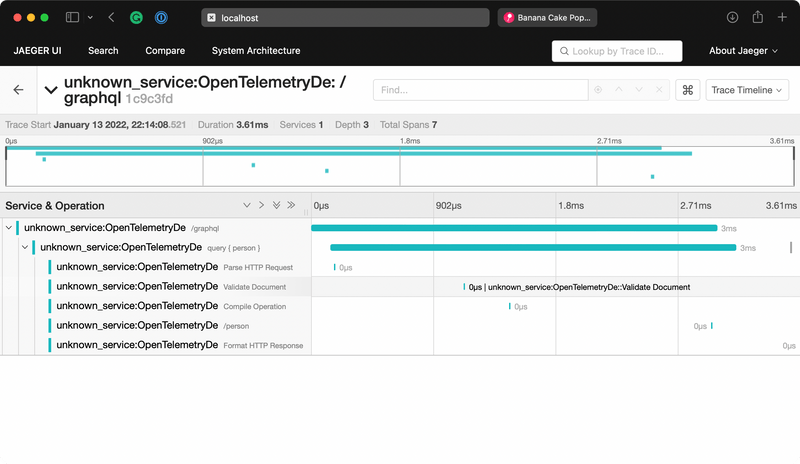Today we have released Hot Chocolate 12.5, and this release is packed with new features. We put a focus on adding some early spec proposals into this release. We also have completely overhauled our GraphQL IDE Banana Cake Pop to include feedback from our community. Lastly, we picked up an issue created by Simon to support OpenTelemetry.
Banana Cake Pop
Let us start with the most visible change to Hot Chocolate. With Hot Chocolate 12.5, we have integrated Banana Cake Pop iteration 22, which introduces themes support. One of the top requests for BCP by users was a Dark mode. With the new version, you can now switch between our light and our dark theme. We will add more themes with one of the subsequent iterations.
We put another focus on discoverability. Many people getting into BCP had difficulty finding the schema explorer or other details regarding their operation document. With the new version, the IDE is much more organized and exposes clearly areas you can dig into.
The new Banana Cake Pop version is now available online at https://eat.bananacakepop.com, as an application that you can download at https://bananacakepop.com or as a middleware in the new Hot Chocolate 12.5.
Open Telemetry
Hot Chocolate for a long time provides instrumentation events that can be used to add your logging solution. By doing this, we did not bind Hot Chocolate to a specific logging/tracing solution or a specific use-case.
But it also meant that almost everyone had to come up with their own solution to instrument Hot Chocolate. With Hot Chocolate 12.5, we have added the HotChocolate.Diagnostics package, which uses the new ActivitySource API.
To add OpenTelemetry to your GraphQL server, first add the activity instrumentation to your schema.
builder.Services .AddGraphQLServer() .AddQueryType<Query>() .AddInstrumentation();
Next, we need to configure OpenTelemetry for our service. To quickly inspect our traces, we will use a Jaeger exported.
builder.Services.AddOpenTelemetryTracing( b => { b.AddHttpClientInstrumentation(); b.AddAspNetCoreInstrumentation(); b.AddHotChocolateInstrumentation(); b.AddJaegerExporter(); });
builder.Logging.AddOpenTelemetry( b => { b.IncludeFormattedMessage = true; b.IncludeScopes = true; b.ParseStateValues = true; });
With all this in place, we can execute requests against our demo server and inspect the traces with the Jaeger UI.
The complete example can be found here.
Docs can be found here.
OneOf Input Objects
One of the most asked-for features in GraphQL is input unions. The GraphQL working group has been discussing this feature for a long time, and we have explored multiple roads to achieve this. The most likely candidate has become the OneOf Input Object representing a structural union. A structural union means that OneOf Input Object is a special kind of input object where each field represents one choice. The OneOf Input Object will only allow one field to be set, and the value can not be null. The type system enforces the rules for OneOf Input Objects_.
We support OneOf Input Objects in all three schema-building approaches (annotation-based, code-first, and schema-first.
In order to make an input object a OneOf Input Object you simply need to annotate it with the @oneOf directive.
schema-first
input PetInput @oneOf { cat: CatInput dog: DogInput}
code-first
public class PetInputType : InputObjectType<PetInput>{ protected override void Configure( IInputObjectTypeDescriptor<PetInput> descriptor) { descriptor.OneOf(); }}
public class PetInput{ public Dog? Dog { get; set; }
public Cat? Cat { get; set; }}
annotation-based
[OneOf]public class PetInput{ public Dog? Dog { get; set; }
public Cat? Cat { get; set; }}
Next, you need to enable the RFC feature on the schema.
builder.Services .AddGraphQLServer() ... .ModifyOptions(o => o.EnableOneOf = true);
The complete example can be found here.
Docs can be found here.
The current GraphQL spec RFC can be found here.
Client-Controlled Nullability
Client-Controlled nullability gives more power to the consumer of a GraphQL API. It allows us to specify error boundaries in GraphQL by defining if a field shall be nullable or required in our GraphQL request. To give this power to the user, the RFC introduces new query syntax to let the user override type nullability on fields and specify where error boundaries are in the GraphQL request.
Let us, for instance, say we have a schema like the following:
type Query { me: User}
type User { name: String! bio: String! friends: [User!]}
We have a user object with a name, a bio, and friends in our schema. Let's now consider we have a simple query where we fetch the currently signed-in user and that user's friends.
{ me { name bio friends { name bio } }}
In our schema, the field bio is a non-null field, and whenever this field would become null due to a processing error or invalid data, the GraphQL non-null propagation rule would erase all friends.
{ "me": { "name": "Michael Staib", "bio": "Author of Hot Chocolate ...", "friends": null }}
With client-controlled nullability, the API consumer can now change this behavior by overriding the field type nullability.
{ me { name bio friends { name bio? } }}
We can tell the execution engine that we do not mind if this field becomes null by adding a question mark.
But we could also approach this differently and say if the field bio does not deliver any data, I do not want a partial result where friends becomes null. I instead want to have no data at all and fail the complete request.
{ me! { name bio friends! { name bio } }}
So, in this case, I added the bang operator to the field me and the field friends. In GraphQL, a non-null violation will bubble up until it reaches a nullable field or until the complete result is deleted. Since we made the root non-null, the complete result, in this case, is deleted. Meaning either I get all the data I demanded or none.
We could also produce null entries in our friends list for users that do not provide a value for the field bio with the new list nullability modifier [?].
{ me! { name bio friends[?] { name bio } }}
At the moment, Banana Cake Pop is not updated for the new syntax yet. We will do that in the coming days. But you can write and execute the new syntax already since BCP will allow you to execute even with syntax errors. We hope to introduce an updated language server with the next iteration.
The current GraphQL spec RFC can be found here.
Conclusion
We have implemented a ton of other smaller additions and bug fixes. Hot Chocolate 12.5 pushes further ahead and allows you to opt into the newest GraphQL spec proposals and drafts. At the GraphQL working group, we are currently discussing great new additions to the GraphQL spec like fragment modularity and object identity. Together, stream/defer, oneof, fragment modularity, object identity, and client-controlled nullability could make GraphQL so much better and help us solve fundamental problems in interacting with our data graphs. We have invested in these new features early and are iterating on these as the spec text matures.



